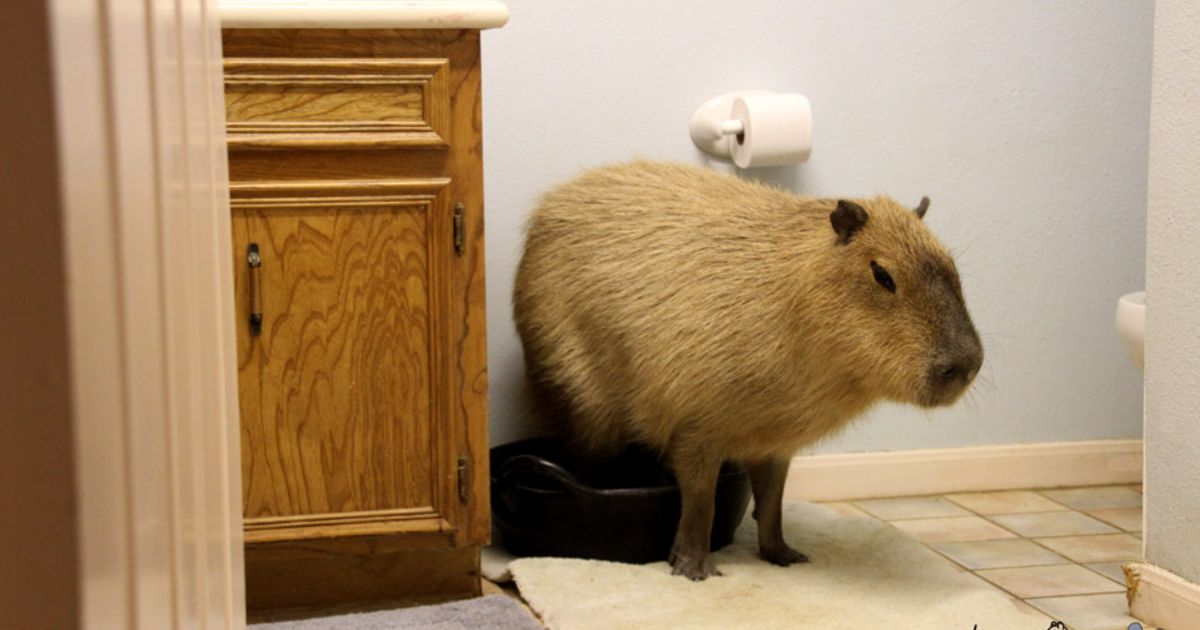Capybaras, those adorable and sociable rodents native to South America, have captured the hearts of animal lovers around the world. Known for their gentle nature and penchant for forming bonds with various other animals, capybaras have gained popularity as pets in some regions. However, one question that often arises is whether these delightful creatures can be potty trained. In this comprehensive article, we’ll explore the possibilities of potty training capybaras, discussing their behavior, the challenges involved, and potential training methods. Whether you’re a capybara owner, an aspiring capybara parent, or simply intrigued by these charming animals, read on to discover the answers you seek.
Understanding Capybaras: Nature and Behavior

Before delving into the realm of potty training, it’s crucial to understand the nature and behavior of capybaras. These large, semi-aquatic rodents, scientifically known as Hydrochoerus hydrochaeris, are the largest rodents in the world, and they are often found in the wetlands and grasslands of South America. Their social and docile nature has made them a sought-after choice for exotic pet enthusiasts. But to potty train a capybara, we need to consider their inherent characteristics:
Social Creatures
Capybaras are highly social animals that prefer living in groups. In the wild, they form large herds and often share their habitat with other species, such as birds, turtles, and even caimans. Their strong social instincts can influence their behavior, including their potty habits.
Herbivorous Diet
Capybaras are herbivores, primarily consuming a diet of grass, aquatic plants, and occasionally fruits and vegetables. Their diet plays a significant role in their digestive system, which, in turn, affects their bathroom habits.
Semi-Aquatic Lifestyle
These rodents are excellent swimmers and often take refuge in water to escape from predators or simply to cool down. Their semi-aquatic lifestyle can influence where and how they relieve themselves.
Communication
Capybaras communicate through a variety of vocalizations, body language, and even scent marking. Understanding their communication cues can be helpful in the potty training process.
Now that we have a better grasp of capybara behavior, let’s explore the possibility of potty training these social animals.
The Challenge of Potty Training Capybaras
Potty training any animal, whether it’s a dog, cat, or capybara, can be a challenging endeavor. With capybaras, there are several factors that make potty training more complex. Many pet owners wonder, “Can a child go to kindergarten not potty trained?” when faced with similar challenges.
Natural Instincts
Capybaras have a natural instinct to defecate and urinate to establish territory and communicate with other capybaras. This instinct may be challenging to overcome.
Group Living
Capybaras often live in groups, and within these groups, they establish communal latrine areas. In a pet setting, it can be tough to mimic these communal habits.
Semi-Aquatic Lifestyle
Capybaras often defecate in the water, which can be difficult to manage in a home environment.
Limited Research
There is limited research on potty training capybaras, and success stories are rare. This lack of information makes it a relatively uncharted territory for capybara owners.
Despite these challenges, there are some potential methods and strategies you can try when it comes to potty training your capybara.
Potty Training Methods for Capybaras
Potty training capybaras may not guarantee the same level of success as with more common household pets, but it is possible to encourage better bathroom habits. Here are some methods and tips to consider:
Crate Training
Crate training is a method often used for dogs and other pets. It involves using a crate or enclosure to create a designated potty area for your capybara. This can help establish a specific location for them to relieve themselves.
Pros of Crate Training:
- Provides a confined space for potty activities.
- Helps prevent accidents in other areas of your home.
Cons of Crate Training:
- Capybaras may resist being confined.
- May not work well for animals that prefer open spaces.
Outdoor Enclosure
Creating an outdoor enclosure with a specific potty area can help mimic the natural communal latrine behavior of capybaras. This is particularly useful if you have a large backyard or outdoor space.
Pros of Outdoor Enclosure:
- Allows capybaras to exhibit natural behaviors.
- Minimizes indoor accidents.
Cons of Outdoor Enclosure:
- May not be feasible for all capybara owners, especially those in urban environments.
Positive Reinforcement
Using positive reinforcement techniques can encourage capybaras to use a designated potty area. Rewarding them with treats or affection when they use the right spot can reinforce the desired behavior.
Pros of Positive Reinforcement:
- Encourages good behavior.
- Strengthens the bond between the capybara and owner.
Cons of Positive Reinforcement:
- May not work for all capybaras, as their motivations can vary.
Consistency and Patience
Consistency and patience are key when potty training any pet. It may take time for your capybara to understand where they should relieve themselves, so be prepared for accidents along the way.
Scent Marking
Capybaras use scent marking to communicate. Placing their droppings in a specific location, such as the designated potty area, can help encourage them to use that spot.
While these methods may help improve your capybara’s bathroom habits, it’s essential to remember that potty training capybaras may not yield perfect results. Be prepared for occasional accidents, and always prioritize the well-being and comfort of your capybara over strict potty training goals.
Tips for Successful Potty Training
To maximize your chances of success when potty training a capybara, consider the following tips:
Start Early
If possible, begin potty training when your capybara is young. Younger animals tend to be more adaptable to new routines and training.
Be Patient
Potty training takes time, and capybaras may not catch on immediately. Be patient and consistent in your approach.
Consistent Schedule
Establish a consistent feeding and bathroom schedule for your capybara. Regularity can help them anticipate when it’s time to relieve themselves.
Use Positive Reinforcement
Reward your capybara with treats, affection, or praise when they use the designated potty area correctly. Positive reinforcement can go a long way in encouraging good behavior.
Supervision
Keep a close eye on your capybara, especially when they are out of their designated potty area. This can help prevent accidents in the house.
Clean Accidents Promptly
If accidents occur, clean them up promptly and thoroughly. This helps avoid lingering scents that might confuse your capybara.
Case Studies: Real-Life Capybara Owners
To gain further insight into the real-world possibilities of potty training capybaras, let’s look at a few case studies of capybara owners who have attempted to train their pets.
The Successful Capybara Trainer
Linda, a capybara owner, successfully potty trained her capybara named “Buddy.” She used a combination of crate training and positive reinforcement. Linda introduced a large crate in Buddy’s enclosure with a separate potty area. Whenever Buddy used the designated potty spot, Linda rewarded him with his favorite treats. It took time and patience, but eventually, Buddy began to use the potty area consistently. Linda’s experience proves that with dedication and the right approach, potty training capybaras is possible.
The Outdoor Enclosure
Chris and Maria, a couple living in a rural area, provided their capybaras with a spacious outdoor enclosure that included a pond. They observed that their capybaras naturally gravitated towards a specific area near the pond for relieving themselves. Chris and Maria decided to create a designated potty area in that spot. Over time, the capybaras consistently used this area for their bathroom needs. This case study highlights the benefits of mimicking the capybara’s natural behaviors in the training process.
The Resistant Capybara
Not all capybaras are equally receptive to potty training. Sarah, another capybara owner, attempted various methods, including crate training and positive reinforcement, but her capybara, Whiskers, proved resistant to these efforts. Whiskers continued to defecate and urinate in different areas of the enclosure. Sarah concluded that some capybaras may be less adaptable to potty training, and owners should be prepared for this possibility.
Potty Training Challenges: What to Expect
While there are instances of successful potty training with capybaras, it’s important to acknowledge the challenges you may encounter along the way:
Individual Variability
Capybaras are individuals, and their responses to potty training methods can vary widely. What works for one capybara may not work for another.
Natural Instincts
Capybaras have strong natural instincts related to territory and communication through scent marking. These instincts can be difficult to override with potty training.
Accidents Happen
Even with the best efforts, capybaras may still have occasional accidents. It’s important to be understanding and patient during the training process.
Long-Term Commitment
Potty training is a long-term commitment. It may take weeks or even months to see consistent results, and maintenance is required to keep up the training.
FAQs
Can Capybaras Be Potty Trained?
Potty training capybaras can be challenging, but it is possible with patience and consistent methods.
What Are Some Potty Training Methods for Capybaras?
Methods like crate training, outdoor enclosures, and positive reinforcement can be used to encourage capybaras to use designated potty areas.
Are Capybaras Always Successful in Potty Training?
Potty training success varies among individual capybaras; some may be more receptive than others, and accidents can still occur.
Conclusion:
Potty training capybaras is a challenging but not impossible task. The success of potty training depends on various factors, including the individual capybara’s personality, the training method employed, and the owner’s dedication and patience. While there are successful case studies, there are also instances where potty training was not fully achievable. As a capybara owner, it’s essential to prioritize your pet’s well-being and comfort over rigid training goals.
If you’re considering potty training your capybara, remember these key points:
- Understand capybara behavior and instincts, which can influence their bathroom habits.
- Use methods like crate training, outdoor enclosures, positive reinforcement, and consistent schedules to encourage good bathroom habits.
- Be prepared for individual variability in response to training.
- Be patient, as potty training can take time.
- Always prioritize your capybara’s welfare and comfort.
Potty training a capybara may not yield the same results as training a dog or cat, but with the right approach and a lot of dedication, you can improve their bathroom habits. If you’re willing to put in the effort and understand the challenges involved, you can provide a happy and healthy environment for your capybara companion.










